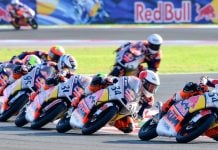HARLEY-DAVIDSON THIRD-QUARTER 2010 EARNINGS MARK CONTINUED PROGRESS Company Generates Earnings Per Share of $0.40 from Continuing Operations Results Reflect Further Strengthening of HDFS Performance, Continued Execution on Company-Wide Restructuring MILWAUKEE, Oct. 19, 2010 — Harley-Davidson, Inc. (NYSE: HOG) reported third-quarter 2010 income from continuing operations of $93.7 million, or $0.40 per share, compared to income of $56.4 million and earnings per share of $0.24 from continuing operations in the year-ago quarter. The Company’s third-quarter earnings from continuing operations were driven by continued performance improvement at the Company’s financial services unit, Harley-Davidson Financial Services (HDFS), as the Company recorded operating income from financial services of $50.9 million, compared to a loss of $31.5 million in last year’s third quarter. Operating income from the motorcycles and related products segment was $101.5 million, compared to $130.7 million in the year-ago period. Third-quarter retail sales of new Harley-Davidson® motorcycles decreased 7.7 percent worldwide, 9.4 percent in the U.S. and 3.6 percent in international markets compared to the year-ago period. “Despite the continued challenges in the economy, we are making solid, steady progress at transforming our business,” said Keith Wandell, President and Chief Executive Officer of Harley-Davidson, Inc. “With our strategic focus on future growth initiatives and continuous improvement, we are positioning Harley-Davidson to succeed at today’s volumes, as well as to grow and restore greater profitability longer term. “The results we are seeing stem directly from the actions we are taking to restructure the business, driven by the creativity and extraordinary efforts of our entire team. From manufacturing and product development to marketing, international operations, dealer capabilities and across the entire enterprise, we are transforming Harley-Davidson with a focus on delivering unparalleled customer experiences and value,” Wandell said. Retail Harley-Davidson Motorcycle Sales During the third quarter of 2010, dealer retail sales of new Harley-Davidson motorcycles decreased 7.7 percent worldwide, 9.4 percent in the U.S. and 3.6 percent in international markets, compared to the prior-year quarter. Industry-wide U.S. heavyweight motorcycle (651cc-plus) retail unit sales decreased 14.4 percent in the third quarter compared to the year-ago period. Through nine months, worldwide retail sales of Harley-Davidson motorcycles decreased 9.8 percent compared to the same period last year. U.S. retail sales of Harley-Davidson motorcycles decreased 13.4 percent for the first nine months of the year while the U.S. heavyweight market segment was down 14.6 percent for the same period, compared to the year-ago period. In international markets, retail sales of new Harley-Davidson motorcycles decreased 1.9 percent for the first nine months of 2010 compared to 2009. “The Harley-Davidson brand has remarkable strength globally. Few products or brands rank as highly in terms of awareness and affinity on the part of customers and non-customers alike. We have continued to gain market share in the U.S. and Europe. Since 2008, we also have been the U.S. leader in new motorcycle sales to young adults for the entire on-road motorcycle category. Going forward, we will continue to build on this brand strength and leadership position,” said Wandell. Third-quarter-and nine-month data are listed in the accompanying tables. Harley-Davidson Motorcycles and Related Products Segment Financial Results Third Quarter: Revenue from Harley-Davidson motorcycles in the third quarter of 2010 was $798.8 million, down 0.6 percent compared to the year-ago period. The Company shipped 53,293 Harley-Davidson motorcycles to dealers and distributors worldwide during the quarter, compared to shipments of 54,236 motorcycles in the third quarter of 2009. Revenue from Parts and Accessories totaled $219.0 million during the quarter, down 1.2 percent, and revenue from General Merchandise, which includes MotorClothes® apparel, was $64.1 million, down 9.4 percent compared to the year-ago period. Gross margin was 34.9 percent in the third quarter, compared to 33.4 percent in the year-ago period. Third-quarter operating margin decreased to 9.3 percent in 2010 from 11.8 percent in the third quarter of 2009, largely the result of higher restructuring and selling, general and administrative charges. Nine Months: Through the first nine months of 2010, the Company shipped 166,013 Harley-Davidson motorcycles, an 11.3 percent decrease compared to last year’s 187,085 units for the period. Revenue from Harley-Davidson motorcycles through nine months was $2.44 billion, a 7.0 percent decrease compared to the year-ago period. Nine-month P&A revenue was $599.8 million, a 3.7 percent decrease from the year-ago period. General Merchandise revenue was $197.7 million, an 8.3 percent decrease compared to the same period in 2009. Gross margin through nine months was 35.5 percent and operating margin was 11.8 percent, compared to 35.0 percent and 15.2 percent respectively in the year-ago period. Financial Services Segment Third Quarter: Operating income from financial services was $50.9 million in the third quarter of 2010, compared to an operating loss of $31.5 million in the year-ago quarter. The improvement in year-over-year operating income is largely the result of a lower cost of funds and improvement in credit losses. Nine Months: Through nine months, operating income from financial services was $138.4 million, compared to an operating loss of $110.8 million in the first nine months of 2009. Nine-month 2009 results were affected by two non-recurring, non-cash charges totaling $101.1 million to establish a credit loss provision related to the reclassification of motorcycle loan receivables and to write off all HDFS goodwill. Guidance The Company is narrowing its guidance for full-year 2010 shipments and now expects to ship 207,000 to 212,000 Harley-Davidson motorcycles to dealers, a decrease of approximately five to seven percent from 2009. Prior shipments guidance was 201,000 to 212,000 motorcycles. The Company is also refining its guidance for capital expenditures, which are now expected to be $190 million to $210 million for the full year, compared to prior guidance of $235 million to $255 million. Capital expenditures guidance for 2010 includes $75 million to $90 million to support restructuring activities, a revision from prior guidance of $95 million to $110 million for restructuring activities in 2010. Harley-Davidson continues to expect gross margin to be between 32.5 percent and 34.0 percent for the full year. Restructuring Update The Company has lowered the cost estimate to complete its restructuring activities and now expects previously announced restructuring activities, which began in 2009, to result in total one-time charges of $505 million to $535 million into 2012, compared to the prior cost estimate of $515 million to $545 million, including charges of $190 million to $210 million in 2010. The Company now expects savings in 2010 of $150 million to $165 million from restructuring activities and continues to expect annual ongoing savings of $290 million to $310 million beginning in 2013 upon completion of the restructuring activities. Last month, Harley-Davidson announced that its Wisconsin labor unions had ratified new labor agreements to take effect in April 2012. Costs and savings related to the new Wisconsin labor agreements are included in the restructuring projections, and savings will first result in a financial benefit upon implementation of the agreements in 2012. Income Tax Rate Through nine months of 2010, the Company’s effective income tax rate from continuing operations was 34.0 percent compared to 47.7 percent for the same period last year. The 2010 effective tax rate through the third quarter was favorably impacted by the settlement of an IRS audit and an increase in the tax benefit from domestic manufacturing, offset by the tax impact of federal healthcare reform legislation. The 2009 effective tax rate for the same period was unfavorably impacted by a one-time tax charge related to a Wisconsin tax law change and a non-deductible goodwill charge. The Company now expects its 2010 full-year effective tax rate from continuing operations to be approximately 34.0 percent. Cash Flow Cash and marketable securities totaled $1.55 billion as of Sept. 26, 2010, compared to $1.52 billion at the end of last year’s third quarter. Through nine months, cash provided by operating activities from continuing operations was $1.17 billion, compared to $561.3 million in the year-ago period, and capital expenditures were $77.6 million in 2010, compared to $76.6 million in 2009. Discontinued Operations In the third quarter, the Company completed the divesture of its MV Agusta subsidiary. For the third quarter of 2010, Harley-Davidson incurred a $4.9 million loss from discontinued operations, net of tax. Through the first nine months of 2010, Harley-Davidson incurred a $108.4 million loss net of tax from discontinued operations, comprised of operating losses as well as fair value adjustments. Including discontinued operations, the Company reported earnings per share of $0.38 in the third quarter of 2010. Company Background Harley-Davidson, Inc. is the parent company for the group of companies doing business as Harley-Davidson Motor Company (HDMC), Harley-Davidson Financial Services (HDFS) and Buell Motorcycle Company (Buell). Conference Call and Webcast Presentation Harley-Davidson will discuss third-quarter results on a Webcast at 8:00 a.m. CT today. The Webcast presentation will be posted prior to the call and can be accessed at http://investor.harley-davidson.com/. Click “Events and Presentations” under “Resources.” Forward-Looking Statements The Company intends that certain matters discussed in this release are “forward-looking statements” intended to qualify for the safe harbor from liability established by the Private Securities Litigation Reform Act of 1995. These forward-looking statements can generally be identified as such because the context of the statement will include words such as the Company “believes,” “anticipates,” “expects,” “plans,” or “estimates” or words of similar meaning. Similarly, statements that describe future plans, objectives, outlooks, targets, guidance or goals are also forward-looking statements. Such forward-looking statements are subject to certain risks and uncertainties that could cause actual results to differ materially from those anticipated as of the date of this release. Certain of such risks and uncertainties are described below. Shareholders, potential investors, and other readers are urged to consider these factors in evaluating the forward-looking statements and cautioned not to place undue reliance on such forward-looking statements. The forward-looking statements included in this release are only made as of the date of this release, and the Company disclaims any obligation to publicly update such forward-looking statements to reflect subsequent events or circumstances. The Company’s ability to meet the targets and expectations noted depends upon, among other factors, the Company’s ability to (i) execute its business strategy and divest certain company assets, (ii) effectively execute the Company’s restructuring plans within expected costs and timing, (iii) successfully achieve with our labor unions flexible and cost-effective agreements to accomplish restructuring goals and long-term competitiveness, (iv) manage the risks that our independent dealers may have difficulty obtaining capital, and adjusting to the recession and slowdown in consumer demand, (v) manage supply chain issues, (vi) anticipate the level of consumer confidence in the economy, (vii) continue to have access to reliable sources of capital funding and adjust to fluctuations in the cost of capital, (viii) manage the credit quality, the loan servicing and collection activities, and the recovery rates of HDFS’ loan portfolio, (ix) continue to realize production efficiencies at its production facilities and manage operating costs including materials, labor and overhead, (x) manage production capacity and production changes, (xi) provide products, services and experiences that are successful in the marketplace, (xii) develop and implement sales and marketing plans that retain existing retail customers and attract new retail customers in an increasingly competitive marketplace, (xiii) sell all of its motorcycles and related products and services to its independent dealers, (xiv) continue to develop the capabilities of its distributor and dealer network, (xv) manage changes and prepare for requirements in legislative and regulatory environments for its products, services and operations, (xvi) adjust to fluctuations in foreign currency exchange rates, interest rates and commodity prices, (xvii) adjust to healthcare inflation and reform, pension reform and tax changes, (xviii) retain and attract talented employees, (xix) detect any issues with our motorcycles or manufacturing processes to avoid delays in new model launches, recall campaigns, increased warranty costs or litigation, and (xx) implement and manage enterprise-wide information technology solutions and secure data contained in those systems. In addition, the Company could experience delays or disruptions in its operations as a result of work stoppages, strikes, natural causes, terrorism or other factors. Other factors are described in risk factors that the Company has disclosed in documents previously filed with the Securities and Exchange Commission. Many of these risk factors are impacted by the current turbulent capital, credit and retail markets and our ability to adjust to the recession. The Company’s ability to sell its motorcycles and related products and services and to meet its financial expectations also depends on the ability of the Company’s independent dealers to sell its motorcycles and related products and services to retail customers. The Company depends on the capability and financial capacity of its independent dealers and distributors to develop and implement effective retail sales plans to create demand for the motorcycles and related products and services they purchase from the Company. In addition, the Company’s independent dealers and distributors may experience difficulties in operating their businesses and selling Harley-Davidson motorcycles and related products and services as a result of weather, economic conditions or other factors.
Harley-Davidson Reporting Increased Profits From “Continuing Operations” During Third Quarter
Harley-Davidson Reporting Increased Profits From “Continuing Operations” During Third Quarter
© 2010, Roadracing World Publishing, Inc.






